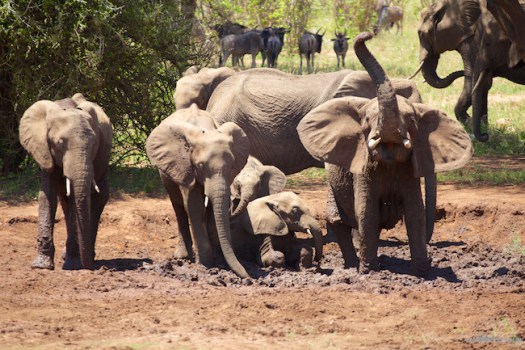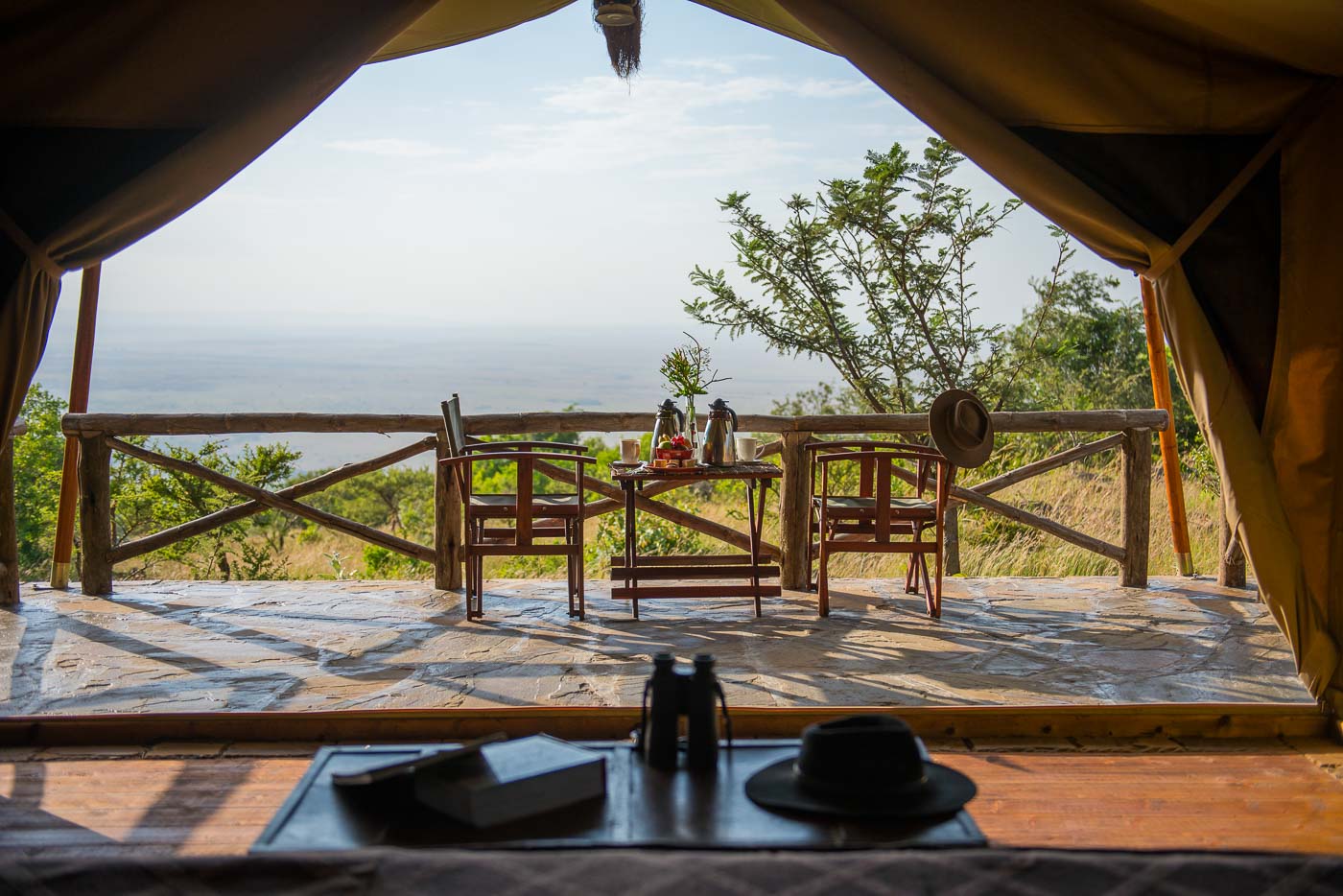I awake just in time for sunrise, rub my eyes and remind myself where I am: Tanzania. I grab my camera and go out to my wrap-around deck, which sits right in the middle of the savanna. An orange glow is low on the horizon shining through the acacia trees. Monkeys and guinea fowl run around in front of me. I hear only nature – rustling in the bushes and the sounds of birds awakening all around me. I grab the yoga mat that is stocked inside my tent and do 20 minutes of chatarangas and sun salutations. Lovely French press coffee is brought right to me on a tray and I sit in wonder.

Sanctuary Swala is about a four-hour drive from Arusha—the first two hours are paved, while the rest is on a dirt road through Tarangire National Park. It’s the first “hotel” at which I’ve stayed where on the way there, I pass zebras, giraffes, and lions.

Upon arrival, an attendant escorts me to my “permanent tent”. One of twelve canvas pavilions, each tent has a bleached hardwood floor, a canvas ceiling with ceiling fan, upholstered chairs in a sitting area, fluffy white duvets on comfy beds, a full en-suite bathroom complete with modern cement slab vanity, double sinks, and an indoor and outdoor shower. There is a wooden deck surrounding the tent and you can sit on your front “porch” and watch zebras and elephants walk right on by. It’s surreal. If this is glamping, I am hooked.

It is hot and dusty in Tanzania, so admittedly one of my favorite things is the complimentary laundry service. There’s nothing like clean clothes for the light packer. One interesting caveat, since they have an all male staff, they do not wash women’s underwear, but do give you detergent in your room so you can hand wash your delicates.
And just in case of any emergency, each tent is equipped with a handheld radio.

At night, I am told to give out a sort of “bat signal.” I simply shine the flashlight that I find charging in my tent up toward the treetops and an askaris (night watchman) comes over and escorts me to the dining room. Seem unnecessary? You have to remember we are just living on the grounds of a national park. There is no fence between us and the wild beasts, just the door of the tent, so at night it’s in our best interest to be careful and still be escorted on the lighted pathways.

Each day at camp, you can join a safari drive, take an early walking safari at dawn, or even go jogging with one of the staff just outside of the park at a local “football” field.
“Feeling adventurous?” asks Chris, the property manager. “Want to go for a little walk in the evening?”
“Sure!” I exclaim without even thinking.

We meet at 5:15pm in the open-air lounge and I sign some “you could die” waivers and get the briefing about safe distances between us and the animals and when we might have to freeze or flee. Oh yeah. This is not just a “walk in the park.” A hike in Tanzania is much different than a hike in any park I’ve ever been to. This is the bush. When on safari we are not allowed to get out of the car. But now we are walking away from our lodge—away from any vehicle or shelter—and are literally just on our own out in the wild with 15,000 pound African elephants (the largest land mammals on earth), dangerous buffalo (they are very unpredictable and kill more people in Africa than any other animal) and lions. The big difference? We are escorted by a park ranger carrying an AK-47 and Chris leads the way also carrying a rifle. Of course, I don’t want to die, but I also really don’t want to put any animal in danger. I started having doubts before we even set out. Why should I risk the life of an animal just so I could get closer? That’s the last reason I came to Tanzania. For better or worse, we only see the elephants that were already at the campsite watering hole (therefore distracted with their bathing and cooling off) and some waterbuck. The most dangerous thing we happen upon are some big termite mounds and huge piles of elephant dung.

Sanctuary Swala sits in a remote corner of Tarangire National Park. While it is one of the least visited in Tanzania, it is also teeming with wildlife—massive herds of elephants, giraffes, cape buffalo, wildebeests, zebras, and lions abound. The park is situated in and around Masai tribe country, which makes for a great introduction to the diverse people and landscape of this amazing country.

Sanctuary Swala is run with the philosophy of “luxury, naturally.” This gives you a great combination of a comfortable stay, with a more natural kind of luxury in a place with a very strong commitment to conservation and responsible tourism. The camp has been built with high eco-standards and is said to have a particularly low carbon footprint. Power is run by generator, which is turned off part of the day, and then there is some low battery charged power. The location was chosen to be close to wildlife without causing any harm or distress. Wastewater is carefully managed and they do not use locally made charcoal as it promotes deforestation, instead they use briquettes, which are made locally from agricultural waste for cooking and heating water. Only biodegradable cleaning products are used and waste is sorted and transported to the city of Arusha for recycling. I also really like that, unlike most other properties I’d stayed at so far, they provide water in glass bottles which they refill everyday instead of using plastic water bottles.

Since it’s a small place, dining at Sanctuary Swala is an intimate affair. The fixed menu rotates every six days and one day each week they have a communal barbecue around the campfire. Breakfast, lunch, afternoon tea, and dinner are included and meals are served on the main dining deck, which is lifted on stilts around an enormous, ancient baobab tree. Breakfast is served before the morning game activity. Lunch can be enjoyed back in camp or picnic baskets can be arranged for guests going out on safari. As evening sets in, there are drinks and canapés around the campfire followed by a three course dinner. And to top it off, there is even an unexpected pizza oven. To be honest, after several days of safari, I loved my time just sitting still in the camp—watching the animals from the lounge and my deck on the edge of the wilderness of Tanzania.
Lisa Lubin is an established travel/food writer, three-time Emmy®-award winning TV producer, and travel industry expert. After a decade in broadcast television she took a sabbatical, which turned into three years traveling around the world. She documents her (mis)adventures on her blog, LLworldtour.com. You can follow her adventures on Facebook, Twitter, and Instagram.
Lisa Lubin is an established travel/food writer, three-time Emmy®-award winning TV producer, and travel industry expert. After a decade in broadcast television she took a sabbatical, which turned into three years traveling around the world. She documents her adventures on her blog, LLworldtour.com. You can follow her on Facebook, Twitter, and Instagram.





















